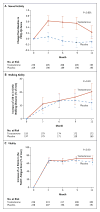Effects of Testosterone Treatment in Older Men
- PMID: 26886521
- PMCID: PMC5209754
- DOI: 10.1056/NEJMoa1506119
Effects of Testosterone Treatment in Older Men
Abstract
Background: Serum testosterone concentrations decrease as men age, but benefits of raising testosterone levels in older men have not been established.
Methods: We assigned 790 men 65 years of age or older with a serum testosterone concentration of less than 275 ng per deciliter and symptoms suggesting hypoandrogenism to receive either testosterone gel or placebo gel for 1 year. Each man participated in one or more of three trials--the Sexual Function Trial, the Physical Function Trial, and the Vitality Trial. The primary outcome of each of the individual trials was also evaluated in all participants.
Results: Testosterone treatment increased serum testosterone levels to the mid-normal range for men 19 to 40 years of age. The increase in testosterone levels was associated with significantly increased sexual activity, as assessed by the Psychosexual Daily Questionnaire (P<0.001), as well as significantly increased sexual desire and erectile function. The percentage of men who had an increase of at least 50 m in the 6-minute walking distance did not differ significantly between the two study groups in the Physical Function Trial but did differ significantly when men in all three trials were included (20.5% of men who received testosterone vs. 12.6% of men who received placebo, P=0.003). Testosterone had no significant benefit with respect to vitality, as assessed by the Functional Assessment of Chronic Illness Therapy-Fatigue scale, but men who received testosterone reported slightly better mood and lower severity of depressive symptoms than those who received placebo. The rates of adverse events were similar in the two groups.
Conclusions: In symptomatic men 65 years of age or older, raising testosterone concentrations for 1 year from moderately low to the mid-normal range for men 19 to 40 years of age had a moderate benefit with respect to sexual function and some benefit with respect to mood and depressive symptoms but no benefit with respect to vitality or walking distance. The number of participants was too few to draw conclusions about the risks of testosterone treatment. (Funded by the National Institutes of Health and others; ClinicalTrials.gov number, NCT00799617.).
Figures

Comment in
-
Establishing a Framework--Does Testosterone Supplementation Help Older Men?N Engl J Med. 2016 Feb 18;374(7):682-3. doi: 10.1056/NEJMe1600196. N Engl J Med. 2016. PMID: 26886526 No abstract available.
-
Testosterone gel improved sexual function, but not walk distance or fatigue, in older men with low testosterone.Ann Intern Med. 2016 May 17;164(10):JC56. doi: 10.7326/ACPJC-2016-164-10-056. Ann Intern Med. 2016. PMID: 27182922 No abstract available.
-
Testosteron für schwache Senioren?MMW Fortschr Med. 2016 Jun 9;158(11):43. doi: 10.1007/s15006-016-8378-7. MMW Fortschr Med. 2016. PMID: 27271412 German. No abstract available.
-
Re: Effects of Testosterone Treatment in Older Men.Eur Urol. 2016 Sep;70(3):539-40. doi: 10.1016/j.eururo.2016.06.029. Epub 2016 Jun 30. Eur Urol. 2016. PMID: 27375034 Free PMC article. No abstract available.
-
Testosterone Treatment in Older Men.N Engl J Med. 2016 Jul 7;375(1):90. doi: 10.1056/NEJMc1603665. N Engl J Med. 2016. PMID: 27406354 No abstract available.
-
Testosterone Treatment in Older Men.N Engl J Med. 2016 Jul 7;375(1):88. doi: 10.1056/NEJMc1603665. N Engl J Med. 2016. PMID: 27406355 No abstract available.
-
Testosterone Treatment in Older Men.N Engl J Med. 2016 Jul 7;375(1):88-9. doi: 10.1056/NEJMc1603665. N Engl J Med. 2016. PMID: 27406356 No abstract available.
-
Testosterone Treatment in Older Men.N Engl J Med. 2016 Jul 7;375(1):89. doi: 10.1056/NEJMc1603665. N Engl J Med. 2016. PMID: 27406357 No abstract available.
-
Testosterone Treatment in Older Men.N Engl J Med. 2016 Jul 7;375(1):89-90. doi: 10.1056/NEJMc1603665. N Engl J Med. 2016. PMID: 27406358 No abstract available.
-
Re: Effects of Testosterone Treatment in Older Men.J Urol. 2016 Aug;196(2):516-9. doi: 10.1016/j.juro.2016.05.062. Epub 2016 May 18. J Urol. 2016. PMID: 27479415 No abstract available.
-
Have the Testosterone Trials demonstrated the effectiveness of testosterone therapy in older men without classical hypogonadism?J R Coll Physicians Edinb. 2016 Sep;46(3):168-171. doi: 10.4997/JRCPE.2016.307. J R Coll Physicians Edinb. 2016. PMID: 27959352 No abstract available.
-
Effects of Testosterone Treatment in Older Men.N Engl J Med. 2018 Oct 11;379(15):1486. N Engl J Med. 2018. PMID: 30318885 No abstract available.
References
-
- Wu FC, Tajar A, Pye SR, et al. Hypo-thalamic-pituitary-testicular axis disruptions in older men are differentially linked to age and modifiable risk factors: the European Male Aging Study. J Clin Endocrinol Metab. 2008;93:2737–45. - PubMed
-
- Harman SM, Metter EJ, Tobin JD, Pearson J, Blackman MR. Longitudinal effects of aging on serum total and free testosterone levels in healthy men. J Clin Endocrinol Metab. 2001;86:724–31. - PubMed
-
- Snyder PJ, Peachey H, Hannoush P, et al. Effect of testosterone treatment on body composition and muscle strength in men over 65 years of age. J Clin Endocrinol Metab. 1999;84:2647–53. - PubMed
-
- Page S, Amory J, Bowman F, et al. Exogenous testosterone (T) alone or with finasteride increases physical performance, grip strength, and lean body mass in older men with low serum T. J Clin Endocrinol Metab. 2004;90:1502–10. - PubMed
Publication types
MeSH terms
Substances
Associated data
Grants and funding
- P30-AG021342/AG/NIA NIH HHS/United States
- P30-AG013679/AG/NIA NIH HHS/United States
- U01 AG030644/AG/NIA NIH HHS/United States
- R01 AG037679/AG/NIA NIH HHS/United States
- P30 DK079626/DK/NIDDK NIH HHS/United States
- R01 AG37679/AG/NIA NIH HHS/United States
- P60 DK079626/DK/NIDDK NIH HHS/United States
- K24 AG021507/AG/NIA NIH HHS/United States
- DK079626/DK/NIDDK NIH HHS/United States
- K07AG043587/AG/NIA NIH HHS/United States
- K07 AG043587/AG/NIA NIH HHS/United States
- P30 AG024827/AG/NIA NIH HHS/United States
- P30 AG028740/AG/NIA NIH HHS/United States
- K24-AG021507/AG/NIA NIH HHS/United States
- P30 AG021342/AG/NIA NIH HHS/United States
- UL1 TR000142/TR/NCATS NIH HHS/United States
- ImNIH/Intramural NIH HHS/United States
LinkOut - more resources
Full Text Sources
Other Literature Sources
Medical
